Spicy Kung Pao Noodles with Veggies
Disclosure: This post may contain affiliate links; more info here.
Craving some spicy stir-fried noodles? These Kung Pao Noodles are my take on the classic Chinese Kung Pao. They’re equal parts spicy, sweet, sour, and salty and will make your tastebuds dance with the zing of Sichuan peppercorns.
Ready in just 30 minutes, these Kung Pao Noodles with Veggies are a flavor bomb in their own right. So addictive and so delicious, you’ll be coming back for seconds (but most likely, thirds!).
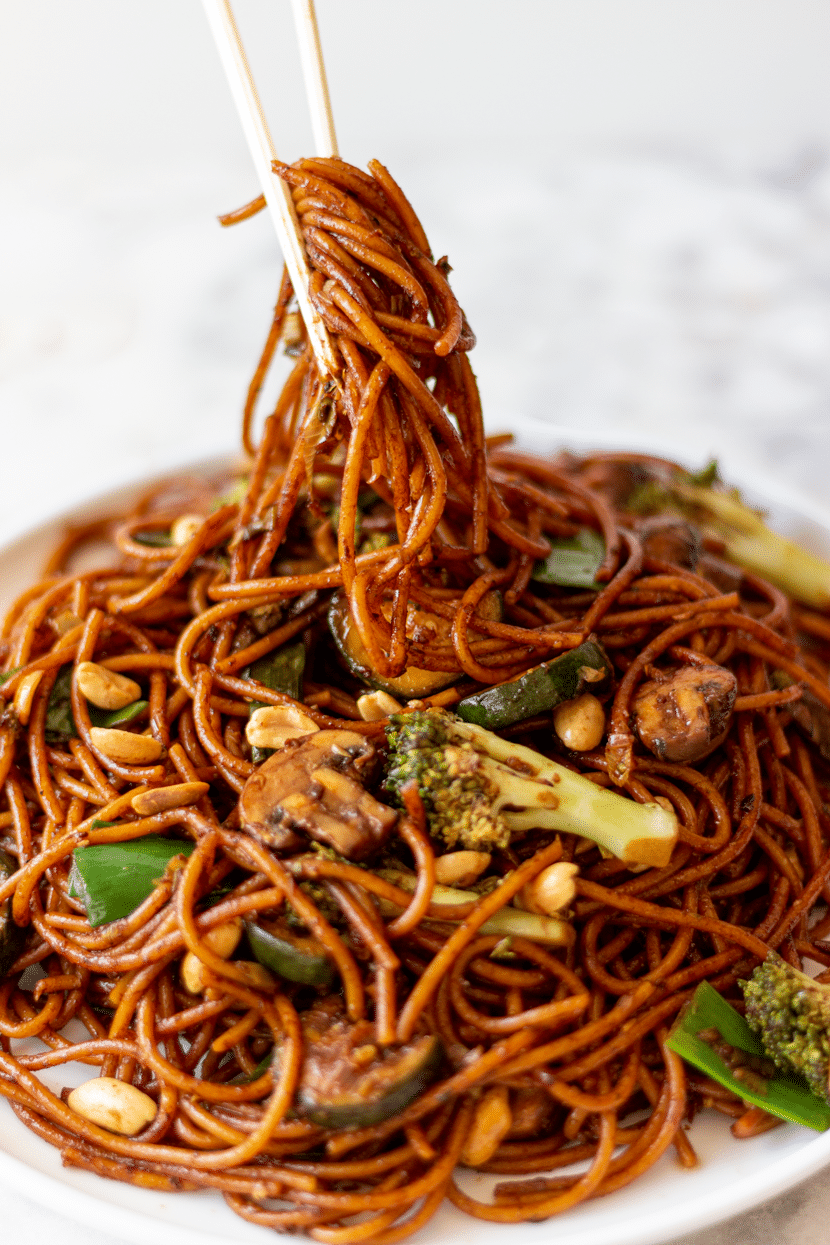
This recipe combines the bold flavors of garlic, ginger, red chilis, and Sichuan peppercorns with a sour-sweet soy sauce, fresh veggies, and crunchy peanuts, to make up the stir-fried noodles of your dreams. Slurpable, noodly goodness, with a real flavor punch. Kung Pao!
Ready to make some Spicy Vegan Kung Pao Noodles with Veggies?
What is Kung Pao?
Kung Pao (AKA Gong Bao or Kung Po) comes from the Sichuan Province of China. If you aren’t familiar, Sichuan cuisine is known for its bold, punchy flavors and liberal use of garlic and hot chilis – though sweet and sour flavors often come through too! And of course, the Sichuan peppercorn is ubiquitous in Sichuanese food.
Traditionally, Kung Pao chicken is a spicy, stir-fried dish of chicken, peanuts, vegetables, chilis – and of course, Sichuan peppercorns. My guess is, you probably know it from your favorite Chinese restaurant.
Kung Pao is a quintessentially Sichuan-style dish: a perfect example of how bold and spicy, sour and sweet, all interplay together.
These Kung Pao Noodles are no exception. While “Kung Pao Noodles” is not a traditional or authentic dish, this stir-fry recipe is pretty close to what you’d expect from Kung Pao chicken. My little noodle spin sticks as closely as possible to the traditional roots of this classic dish.
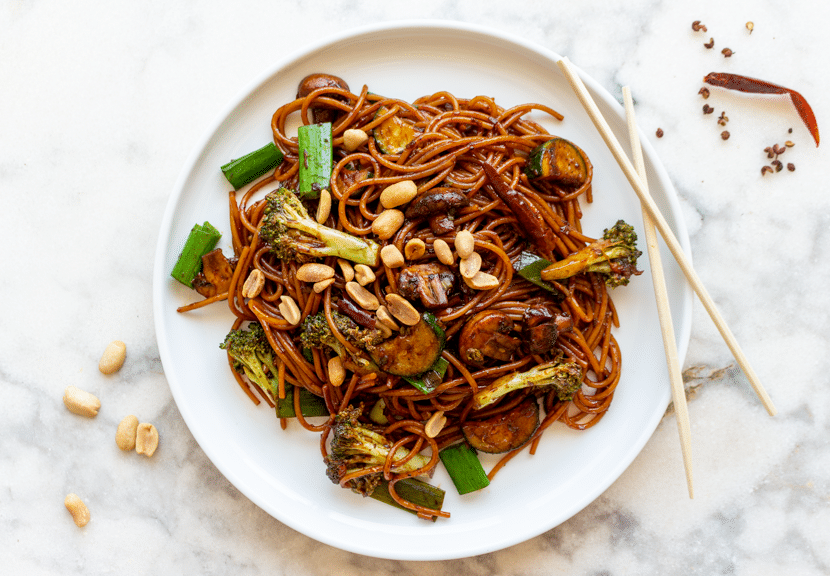
What is Kung Pao Sauce Made Of?
Kung pao sauce is equal parts savory, sweet, and sour.
To make this Kung Pao sauce, you will need:
- Light soy sauce
- Dark soy sauce
- Chinese (Chinkiang) black vinegar
- Chinese (Shaoxing) cooking wine
- Sesame oil
- Sugar
- Water
- Corn starch
light soy sauce vs. dark soy sauce
Light soy sauce is not the same as low-sodium soy sauce, so make no mistake! Light soy is salty, reddish-brown in color, thin in viscosity, and has a light flavor. It’s essential in many Asian cuisines.
Dark soy sauce is not the same as regular/all-purpose soy sauce. Contrary to light soy, dark soy sauce is almost black. It is reduced down, so it’s thicker, darker, sweeter, and less salty than light soy sauce. It’s aged longer and has a more full-bodied flavor. Dark soy is a pillar of Chinese cooking.
Why use both? Combining light soy sauce and dark soy sauce creates a deep color and a balanced, full-bodied, rich sauce that will caramelize whatever you’re stir-frying.
*My Black Pepper Tofu & Broccoli Stir-Fry also uses light and dark soy together. This one’s a must-try!
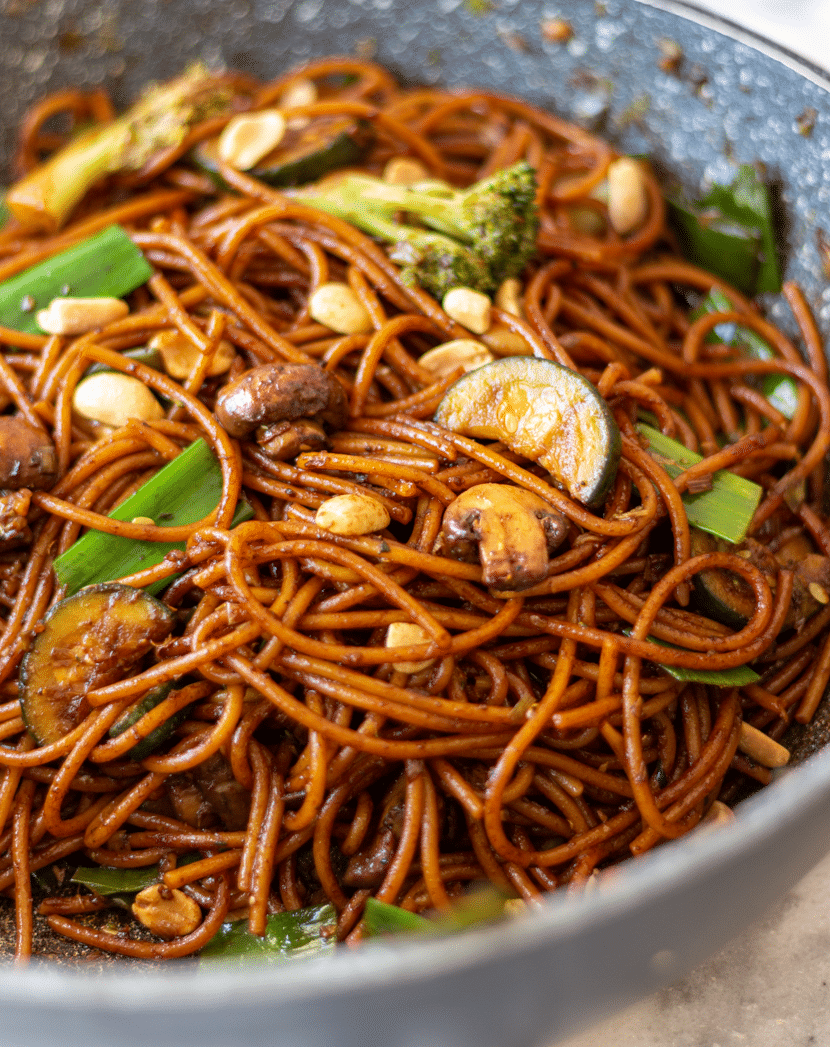
Chinese (Chinkiang) Black Vinegar
Chinkiang is another pantry staple in Chinese cooking. Like balsamic vinegar, Chinkiang has a deep, complex flavor, but it’s not quite as sweet. It’s the perfect match for soy sauces, cutting through the saltiness with a little hit of acidity. Use it to brighten up stir-fries or dipping sauces.
Chinese (Shaoxing) cooking wine
Shaoxing is cooking wine fermented from rice. It’s very fragrant, slightly sweet, a little spicy, a little nutty, and has a strong alcoholic taste. It’s hard to explain, but one thing’s for sure: it is delicious. Similar to how the French and Italians cook with wine, Shaoxing adds depth to whatever you’re cooking.
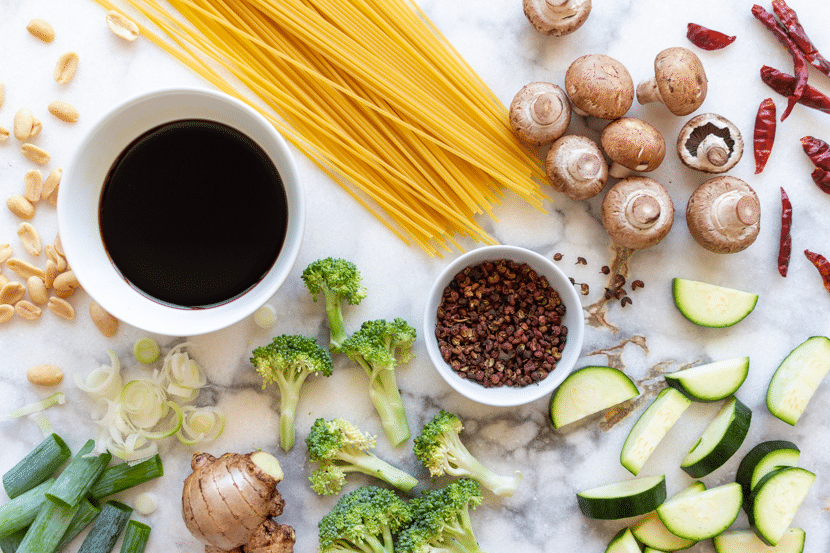
Ingredients for Vegetarian Kung Pao Noodles
In addition to the sauce ingredients listed above, you will also need the following ingredients:
- Garlic cloves
- Fresh ginger
- Dried Sichuan chilies (whole)
- Zucchini
- Broccoli
- Brown mushrooms
- Green onions
- Sichuan peppercorns
- Roasted peanuts
- Wheat noodles (like chow mein, lo mein, ramen, spaghetti)
- Flavorless cooking oil (like sunflower or grapeseed oil)


Sichuan/Szechuan peppercorns
The most important ingredient in any Kung Pao dish is the Sichuan peppercorns. Without these peppercorns, you won’t have Kung Pao Noodles… you’ll just have, well… noodles. So don’t skip them!
They have an addictive, tingly, mouth-numbing quality. In a good way! It’s not spicy, hot heat; it’s tingly heat. They taste peppery, but also a little floral and lemony.
You can buy pre-toasted and ground Sichuan peppercorns OR whole peppercorns to toast and grind yourself. Using whole peppercorns will make your noodles more flavorful, but you may end up with a grittier texture.
PrintKung Pao Noodles with Veggies
Ready in just 30 mins, these Kung Pao Noodles with Veggies are so addictive, you’ll be coming back for seconds (and maybe even thirds)! This recipe combines the bold flavors of garlic, ginger, red chilis, and Sichuan peppercorns with a sour-sweet soy sauce, fresh veggies, and crunchy peanuts, to make up the stir-fried noodles of your dreams.
- Prep Time: 15 mins
- Cook Time: 15 mins
- Total Time: 30 mins
- Yield: 2–3 servings 1x
- Category: Dinner
- Method: Stir-Fry
- Cuisine: Chinese
- Diet: Vegan
Ingredients
SAUCE
- 2 tsp corn starch
- 1 tbsp light soy sauce*
- 1 tbsp dark soy sauce*
- 2 tbsp Chinese (Chinkiang) black vinegar*
- 1 tbsp Chinese (Shaoxing) cooking wine*
- 1 tsp sesame oil
- 2 tbsp sugar + 1/3 cup hot water to dissolve the sugar
STIR-FRY
- 2 tbsp flavorless cooking oil (sunflower, grapeseed, etc.)
- 2–3 cloves garlic, minced
- 2 tsp fresh ginger, grated or minced
- 6–8 whole dried Sichuan red chilis, halved, seeds removed
- 1 large zucchini, sliced, halved (1.5 cups)
- 1/2 small head of broccoli, cut into bite-size pieces (1 cup)
- 8–10 brown mushrooms, halved (2 cups)
- 3 green onions, white parts cut into 1cm pieces – green parts cut into 3cm pieces
- 2 tsp Sichuan peppercorn powder (OR whole, then toasted and ground)*
- 1/2 cup roasted peanuts, chopped
- 1/2 packet of wheat-based noodles (250g or 9oz) like chow mein, lo mein, ramen, or spaghetti
Instructions
- MAKE THE SAUCE: In a bowl, whisk together the sauce ingredients and set aside.
- PREP THE INGREDIENTS: Chop, slice, and mince the veggies as directed above. Cook the noodles according to their package instructions. (Note: Make sure not to overcook the noodles because they will cook for another minute in the sauce later. Al dente is perfect.)
- STIR-FRY THE AROMATICS: Heat your wok over high heat. Add oil. Once the oil is hot, stir fry the garlic, ginger, and chili until fragrant – about 45 seconds.
- ADD IN THE VEGGIES: Add in the zucchini, broccoli, mushrooms, and white parts of the green onions. Continue stir-frying until the vegetables are cooked through, but the zucchini and broccoli still have a little crunch. This should only take 5 minutes. Add a little more oil if needed. (If your wok is too small or your stove/wok doesn’t get hot enough, this process may take longer, and you may need to do this in two batches, then recombine.)
- ADD THE SAUCE AND NOODLES: Make sure the wok is still super hot. Re-stir the sauce to recombine it, then add the sauce, Sichuan peppercorns, and pre-cooked noodles into the wok with the veggies. Toss everything together, bring the sauce to a boil, then turn it down to a simmer, allowing the sauce to thicken. Keep tossing all the while. Once thickened, turn off the stove and remove it from the heat. This should only take 1 or 2 minutes.
- GARNISH AND SERVE: Stir in the peanuts and dark parts of the green onions. Serve immediately!
Notes
*LIGHT SOY: Light soy sauce is not the same as low-sodium soy sauce. It’s salty, reddish-brown in color, thin in viscosity, and has a light flavor.
*DARK SOY: Dark soy sauce is not the same as regular soy sauce. Contrary to light soy, dark soy sauce is almost black. It is reduced down, so it’s thicker, darker, sweeter, and less salty than light soy. It has a more full-bodied flavor.
*CHINKIANG: You can get Chinese (Chinkiang) black vinegar on Amazon. Using Chinkiang will yield the best, most delicious results. However, if you absolutely need to substitute it, you can use rice vinegar – or even balsamic vinegar (just be mindful of your sauce becoming too sweet).
*SHAOXING: You can get Chinese (Shaoxing) cooking wine on Amazon. I highly recommend using Shaoxing – this is the authentic way. However, if you need a substitute, you can use mirin (sweet Japanese rice wine). If you use mirin, use less sugar in the sauce, because mirin is quite sweet.
*DRIED SICHUAN CHILIS: Can’t handle the heat? Don’t omit the dried red chilis. Add them into the stir-fry as directed, but eat around them or remove them. You need their flavor, but you don’t need to set your mouth ablaze!
*SICHUAN PEPPERCORNS: The most important ingredient in any Kung Pao dish is the Sichuan peppercorns. Without these peppercorns, you won’t have Kung Pao Noodles… you’ll just have, well… noodles. So don’t skip them!
*NOODLES: Avoid using rice noodles in this recipe. Use a wheat-based noodle, like chow mein, ramen, or spaghetti. If you are gluten-free, you can use buckwheat noodles, like soba noodles.


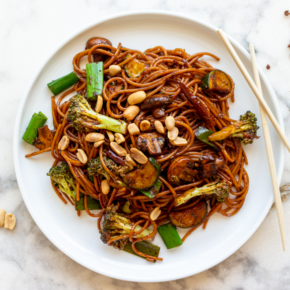

Loved these noodles. They weren’t as complicated to make as I though! Thanks for sharing.
Loved these noodles! They had a great amount of spice and the perfect amount of sauce. I also loved the combination of vegetables and the crunchy peanuts on top. I will make it again. Thanks!
Thank you so much for putting the steps and ingredients of this recipe. I made this for my kids and they really loved it a lot keep sharing such recipes my kids really love them.
Thanks, Supriya! I am so glad that your kids loved this recipe :)
Easy, spicy, and very yummy. Will make again. Thanks for sharing.
Thanks so much, Sam!
Loved these!
Glad to hear it!
I tried making this recipe and I am very happy because the first time I could make something so perfect and so delicious and all this is because of you thank you so much for sharing this post do share such post they really mean a lot.
Yay! Thanks for your review!
I love Chinese food, so I already had all the sauces to make this dish. I used spaghetti for the noodles and also added some tofu in the stir fry step for some extra protein. Will make again!
Awesome. Thank you for the review, Liane!